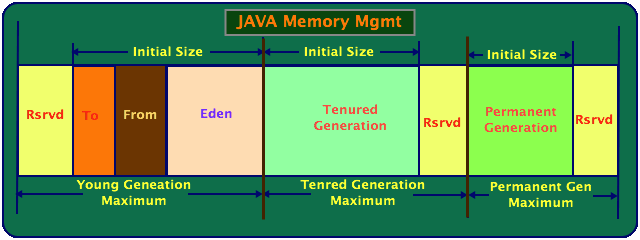This is continuation of the previous post. As i mentioned earlier, the Java Memory is divided into multiple generations for the performance of JVM as explained below.
- Permanent Generation
- Old or Tenured Generation
- Young Generation
Each of the above spaces (with minimum and maximum values) can be configurable through the command line parameters. If not configured, JVM defaults each of these based on the mode of JVM and the platform running. Initial size is the size allocated during the startup of JVM irrespective of the usage of the application and the remaining size will be reserved. When application is running out of the initial size, then it starts using the remaining space until the the maximum size is reached. Once the size reached maximum and memory can't be allocated, it throws an OutOfMemoryError exception. The total size of the heap is configured using
- -Xms: The minimum size of the heap space
- -Xmx: The maximum size of the heap space
Permanent Generation
Permanent generation is the part of the heap memory where the class meta data and string constants are stored. This is also one of the space which is garbage collected. Most of us (including me) think that Permanent generation is created and never GCed. GC will run on the permanent generation when there are no references on the constants or the constants are never used. The Permanent Generation space is configurable using the following two parameters
- -XX:PermSize: Initial permanent generation size during the start of VM.
- -XX:MaxPermSize: This is the maximum size of the permanent generation which can be expanded up-to from initial size.
Old Generation
As the name indicates, this is the pool of the objects which are survived during the full GCs. These are the objects copied from the survivor spaces (Will see this very shortly). The size of the old generation is always relative to the young generation. The parameters will be explained in conjunction with Young Generation
Young Generation
The new objects are always created in the Eden space of the Young Generation. When GC happens, the objects which are survived will be moved to the Survivor space 1 (From). Subsequently, the objects survived in the From Survivor Space will be moved to To Survivor Space. So, in short the objects are initially created in Eden and survived objects will be moved to From and To Survivor spaces and Eden space is cleared to create more new objects.
The size of the survivor space can be set relative to the Eden Space using the option -XX:SurvivorRatio. The sizes of two survivor spaces will be same. So, if we set-XX:SurvivorRatio=6, each survivor space will be one-eight of the young generation and Eden will be six-eight.
The parameters -XX:NewSize and -XX:MaxNewSize are the initial and maximum sizes of the Young generation. The ratio between Young and Old generation is set using -XX:NewRatio. If we set -XX:NewRatio=3, then the total young generation (both Eden and Survivor space) will be one-third of the total heap size.
Command line parameters
- -Xms size: The minimum size of the Heap Space.
- -Xmx size: The maximum size of the Heap Space.
- -XX:NewSize=size: The initial size of the Young Generation.
- -XX:MaxNewSize=size: The maximum size of the Young Generation.
- -XX:SurvivorRatio=ratio: The ratio between survivor space and the Eden space.
- -XX:NewRatio=ratio: The ratio between Young and Old Generations.
- -XX:+AggressiveHeap: This parameters let the JVM to allocate the as much space as possible until the space is available on the machine. This is one of the GC tuning option to be set for long running programs. (May be for the application servers).
Points to remember
- If the NewRatio is high, then the time between full GCs will be more
- If the survivor spaces are tool small, then the objects will be directly moved to Old Generation without using the Survivor in case of Large objects.
- The young and old generations are always related to minimum and maximum sizes of the Heap.
In the next post, we will see more details on the GC and moving objects between different generations.
Happy Learning!!!!

No comments:
Post a Comment